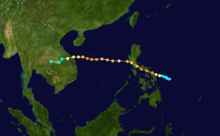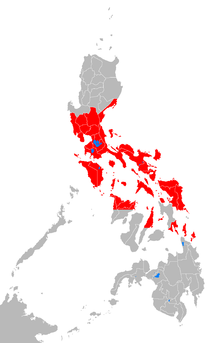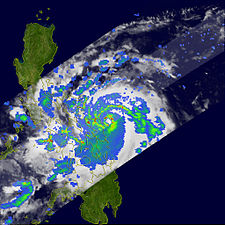- Typhoon Xangsane
-
This article is about the 2006 typhoon. For other storms of the same name, see Typhoon Xangsane (disambiguation).
Typhoon Xangsane (Milenyo) Typhoon (JMA) Category 4 typhoon (SSHS) 
Xangsane east of the Philippines on September 27 Formed September 25, 2006 Dissipated October 1, 2006 Highest winds 10-minute sustained:
175 km/h (110 mph)
1-minute sustained:
230 km/h (145 mph)Lowest pressure 935 mbar (hPa; 27.61 inHg) Fatalities At least 312 total[1][2][3] Damage $750 million (2006 USD) Areas affected Philippines, Hainan, Vietnam, Cambodia, Thailand Part of the 2006 Pacific typhoon season Typhoon Xangsane (international designation: 0615, JTWC designation: 18W, PAGASA name: Typhoon Milenyo) was a deadly typhoon that affected the Philippines, Vietnam, and Thailand during the 2006 Pacific typhoon season. It was the fifteenth tropical storm and ninth typhoon recognized by the Japan Meteorological Agency operationally during the season, although in post-operational analysis it became the tenth typhoon of the season with the addition of Typhoon Maria. According to the Joint Typhoon Warning Center, Xangsane was the sixteenth tropical storm and tenth typhoon of the season, and was a Category 4-equivalent typhoon in terms of 1-minute average wind speeds. The name Xangsane was submitted by Laos and means elephant.[4]
Xangsane made landfall in the Philippines, battering the northern islands with torrential rains and strong winds, and causing widespread flooding and landslides. After passing over Manila and emerging over the South China Sea, the typhoon made a second landfall in central Vietnam, also causing flooding and landslides there and in Thailand. The storm was responsible for at least 279 deaths, mostly in the Philippines and Vietnam, and at least $747 million (2006 USD) in damage.[1][5][6]
Contents
Meteorological history
Late on September 24, 2006, the Joint Typhoon Warning Center, noted that an area of convection, had persisted about 460 NM to the southeast of Manila, in the Philippines.[7] The JTWC assessed the development of a significant Tropical cyclone, as fair.[7] This was because convection was beginning to flare up near a developing Low Level Circulation Center, the JTWC also noted that the disturbance had a broad circulation.[7] Early the next day both the Japan Meteorological Agency and the Philippine Atmospheric, Geophysical and Astronomical Services Administration (PAGASA) designated the Tropical disturbance as a Tropical Depression with PAGASA assigning the local name of Tropical Depression Milenyo, to the depression.[8][9] Later that morning the JTWC reassessed the potential of the disturbance forming into a significant tropical Cyclone within 24 hours as good, and issued a Tropical Cyclone Formation Alert on the developing disturbance.[10] Early that afternoon the JTWC started to issue advisories on the disturbance and designated it as Tropical Depression 18W.[10] Later that day the JTWC upgraded as the depression moved towards the west it was upgraded to a Tropical Storm by the JTWC.[11] Early on September 26 the JMA also upgraded the depression to a tropical storm, and assigned the international name of Xangsane.[12]
Later on September 26, the JMA upgraded Xangsane to a severe tropical storm, whilst six hours later both the JMA and the JTWC upgraded Xangsane to typhoon with the JTWC reporting wind speeds equivalent to a category one typhoon.[12][13] Early the next day Xangsane was upgraded to a category 2 typhoon and then over the next six hours Xangsane rapidly intensified into a category 4 typhoon with wind speeds of 115 kts (130 mph, 215 km/h).[14] Meanwhile the JMA reported that Xangsane had reached its peak wind speeds of 85 kts (100 mph, 155 km/h).[12] Early that afternoon the JTWC reported that Xangsane, had reached its peak wind speeds of 125 kts (145 mph, 230 km/h).
Xangsane then passed through the Philippine islands, wreaking havoc and becoming the strongest typhoon to directly impact Metro Manila in eleven years.[15] As it entered the South China Sea as a weak typhoon, it began to re-intensify, reaching its secondary peak strength shortly before landfall at Danang, Vietnam on October 1. The JTWC ceased advisories after landfall, while the JMA carried the storm inland until it was over Thailand as a tropical depression. It remained as a low pressure area over central Indochina on the JMA's weather charts for several days, while the U.S. Navy's Automated Tropical Cyclone Forecasting system carried the remnants of Xangsane into the Bay of Bengal.[citation needed]
Preparations
Philippines
Costliest Philippine typhoons Rank Name Year PHP USD 1 Parma (Pepeng) 2009 27.3 billion 608 million 2 Nesat (Pedring) 2011 15 billion 333 million 3 Fengshen (Frank) 2008 13.5 billion 301 million 4 Ketsana (Ondoy) 2009 11 billion 244 million 5 Megi (Juan) 2010 11 billion 255 million 6 Mike (Ruping) 1990 10.8 billion 241 million 7 Angela (Rosing) 1995 10.8 billion 241 million 8 Flo (Kadiang) 1993 8.75 billion 195 million 9 Babs (Loleng) 1998 6.79 billion 151 million 10 Xangsane (Milenyo) 2006 6.61 billion 147 million Source: [1], [2], [3] On September 27, PAGASA issued Storm Signal Number 3, a warning for winds of 100 – 185 km/h (62 – 115 mph), for areas of southern Luzon. Storm Signal Number 2, for winds of 60 – 100 km/h (37 – 62 mph), was raised for northern Samar Island and central Luzon. Storm Signal Number 1 (30 – 60 km/h, 20 – 37 mph) was issued for northwestern Luzon, including Metro Manila, and northern Visayas, including the rest of Samar Island. Schools in the warned area were suspended, and airports and seaports were closed. Philippine Airlines cancelled over half of its flights to and from Ninoy Aquino International Airport for September 28, and various transit services also suspended service.[16] Metro Manila and the Tagalog provinces were warned of possible flooding and strong winds.[17]
When it became clear that Xangsane would approach the Capital, PAGASA upgraded the warning for Manila and central Luzon to Storm Signal Number 3 on September 28. All the storm signals were discontinued later that day.[18]
Vietnam
Prior to Xangsane's final landfall, the Vietnamese government set up a steering committee headed by Deputy Prime Minister Nguyen Sinh Hung to oversee evacuations and storm preparations throughout central Vietnam.[19] Provincial and local authorities evacuated over 300,000 people from low-lying areas along the coast from Ha Tinh to Phu Yen, as well as hilly areas prone to landslides. The Vietnamese government also ordered about 2,400 boats, including 273 fishing boats, to return to port.[20] Vietnam Airlines, the national airline, cancelled or diverted all flights on September 30 and October 1.[21] These efforts were carried out in order to prevent a repeat of the damage and fatalities caused by Typhoon Chanchu earlier in the season.[22]
Thailand
Although Xangsane had weakened considerably over land, residents of northern Thailand were advised of the threat of flooding from the remnant low of Xangsane as it approached. The Department of Disaster Prevention and Mitigation alerted its provincial offices throughout the country to be prepared for strong winds, flash flooding, and landslides. Residents in highland areas were also warned of possible mudslides, and the army was dispatched to aid in regional storm preparations.[23]
Impact
Philippines
Damage was widespread in the Philippines, particularly in Metro Manila, where the typhoon passed almost directly over. Power and water was lost in several provinces, while overflowing rivers caused flooding, landslides and made roads impassable. In some parts of the country, electricity was cut of for up to six days straight.[24] Many trees and billboards were toppled by Xangsane, while Luzon suffered an island-wide power outage.[15] Rough waters and seaport closures left at least 3,400 people and nearly 270 vehicles stranded in ports and terminals, mainly at the primary ferry crossing between Samar Island and Bicol Region.[25] Local and provincial officials described Xangsane as the worst typhoon to directly impact Manila since Typhoon Angela passed over the city eleven years ago.[15]
The Philippine government estimated that approximately 2 million people in 19 provinces were affected by Xangsane,[26] which destroyed many homes and farms on its path through the islands.[24] The local and regional Philippine National Red Cross chapters reported major damage in at least 116 municipalities, 12 cities, and a total of 1,295 barangays across the country. Torrential rains from Milenyo also caused flooding and landslides in Laguna, Cavite, and Quezon.[27] Xangsane caused the destruction of the Calumpang Dam in the Municipality of Liliw, which channeled water to irrigation canals around the area. In all, Milenyo was responsible for 197 deaths[1] and 5.9 billion Philippine pesos ($118 million, 2006 USD) in damage, mostly to personal property and agriculture.[5]
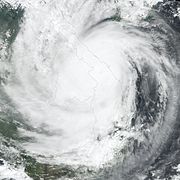 Xangsane inland over eastern Indochina
Xangsane inland over eastern Indochina
Vietnam
Xangsane made its second and final landfall in central Vietnam, causing severe flooding and strong winds that caused nearly 10 trillion Vietnamese dong ($629 million, 2006 USD) in damage and killed 71 people. The worst structural damage occurred in the city of Da Nang, where 26 people were killed. The provinces of Quang Nam and Nghe An were also hard hit, with a total of 25 people killed.[1] The storm damaged or destroyed around 320,000 homes, downed thousands of trees and power lines, and flooded major streets.[28]
Significant agricultural damage was reported, especially in the province of Quang Binh. More than 3,000 square kilometres (1,200 sq mi) of crops, mostly rice, were damaged or washed away by the floodwaters.[29] There were also reports of heavy losses of poultry and livestock, and nearly 13 km² (5 sq mi) of aquaculture and 786 fishing boats were lost.[30]
Thailand
The remnants of Xangsane moved over Thailand on October 2 and combined with monsoonal moisture over the north central part of the country, causing torrential rains and severe flooding in over 35 provinces. Floodwaters broke through levees and barriers and flooded or damaged nearly 1.3 million rai (2,100 km², 520,000 acres) of farmland and local infrastructure.[31] Many municipalities reported flooding of up to three meters (10 ft),[31] and the municipality of Angthong reported flooding of 60 cm (2 ft).[32] The Department of Disaster Prevention and Mitigation reported 47 deaths,[33] and villages in several provinces reported significant levels of water pollution and waterborne illnesses from stagnant waters.[34]
Aftermath
Philippines
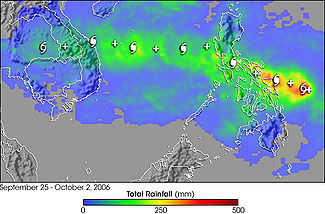 This image shows rainfall totals for Southeast Asia for September 25 – October 2, 2006 estimated in part from data collected by the Tropical Rainfall Measuring Mission satellite. Storm symbols mark out the path of the typhoon. Totals of over a foot are shown over Samar in the east-central Philippines (red areas). A broad area of 4- to 8-inch totals (green) stretches from the central Philippines to the coast of Vietnam.
This image shows rainfall totals for Southeast Asia for September 25 – October 2, 2006 estimated in part from data collected by the Tropical Rainfall Measuring Mission satellite. Storm symbols mark out the path of the typhoon. Totals of over a foot are shown over Samar in the east-central Philippines (red areas). A broad area of 4- to 8-inch totals (green) stretches from the central Philippines to the coast of Vietnam.
Following the passage of Xangsane, the International Federation of Red Cross and Red Crescent Societies (IFRC) issued an emergency request for 5.7 million Swiss francs ($4.6 million, 2006 USD) to aid the Philippine Red Cross in its relief effort. In addition, the movement dispatched 3,000 workers and three disaster response teams to affected areas for search and rescue missions, damage assessments, and assistance to people affected by the typhoon. The Philippine Red Cross provided canned goods, rice, clothing, and personal hygiene items to over 6,300 families, and local volunteers provided assistance to people in shelters.[35] The Spanish Red Cross, present since 1998 as a backup to the Philippine Red Cross, also sent officials, logistics equipment, and water purification systems to the more heavily areas to aid in disaster relief and damage assessments.[24]
 A passenger bus is crushed by a billboard structure along EDSA at the Magallanes interchange in Makati City.
A passenger bus is crushed by a billboard structure along EDSA at the Magallanes interchange in Makati City.
In Manila, fallen billboards killed several people and caused traffic delays along EDSA, the main highway of the metropolis. This prompted some members of the Senate of the Philippines to push for the removal and banning of billboard advertising in the Manila area, which had been an issue for some time. Senator Miriam Defensor-Santiago wrote an appeal to President Gloria Macapagal-Arroyo, asking her to approve the "Anti-Billboard Blight Act of 2006", which would ban billboard advertising on major thoroughfares within Metro Manila.[36]
Vietnam
On October 3, the IFRC released 100,000 Swiss francs ($80,300, 2006 USD) from its disaster relief fund to support the Red Cross of Vietnam,[35] and issued an emergency appeal for 1 million Swiss francs ($810,000, 2006 USD) in aid the next day. The Vietnamese government also released 100 billion Vietnamese dong ($6.2 million, 2006 USD) and 1,500 metric tons (1,650 short tons) of rice from the national food security stock to help the recovery effort in central Vietnam. The National Fatherland Front also issued an appeal to national and international organizations for donations and aid.[30]
Thailand
The Department of Disaster Prevention and Mitigation and the Thai Red Cross Society evacuated residents from areas of central Thailand that had been affected by flooding from the remnants of Xangsane. The Red Cross also provided victims and evacuees with food and emergency kits, and several Red Cross health centers in 12 provinces issued emergency relief kits, drinking water, and medicine kits to at least 16,000 families in flood-stricken areas.[31]
Retirement
As a result of the deaths and damage caused, it was decided at the 39th annual meeting of the ESCAP/WMO Typhoon Committee in Manila in December 2006 that the name Xangsane, along with four others, would be retired from the name list. Its PAGASA name, Milenyo, was also retired by PAGASA.[37] In December 2007, the committee selected the name Leepi to replace Xangsane on the Western Pacific basin name lists beginning in 2008.[38] In 2010 the name selected by PAGASA to replace Milenyo was Mario.
See also
- Typhoon Ketsana
- 2006 Pacific typhoon season
- Tropical cyclone
- List of tropical cyclones
- Timeline of the 2006 Pacific typhoon season
References
- ^ a b c d Xinhua News Agency (2006-10-06). "Typhoon, flood claim 71 lives in central Vietnam". ReliefWeb. http://www.reliefweb.int/rw/RWB.NSF/db900SID/VBOL-6UBDD7?OpenDocument. Retrieved 2006-10-08.
- ^ Agence France-Presse (2006-10-04). "Philippines still assessing damage from typhoon Xangsane". ReliefWeb. http://www.reliefweb.int/rw/RWB.NSF/db900SID/KHII-6U98TF?OpenDocument&rc=3&emid=TC-2006-000144-PHL. Retrieved 2006-10-08.
- ^ Agence France-Presse (2006-10-03). "Typhoon death toll nears 250 in Vietnam, Philippines". ReliefWeb. http://www.reliefweb.int/rw/RWB.NSF/db900SID/VBOL-6U8DWE?OpenDocument&rc=3&cc=phl. Retrieved 2006-10-08.
- ^ RSMC Tokyo - Typhoon Center. "List of names for tropical cyclones adopted by the Typhoon Committee for the western North Pacific Ocean and the South China Sea". Japan Meteorological Agency. http://www.jma.go.jp/jma/jma-eng/jma-center/rsmc-hp-pub-eg/tyname.html. Retrieved 2006-10-08.
- ^ a b Government of the Philippines (2006-10-04). "NDCC media update effects of Typhoon "Milenyo" (Xangsane) - 04 Oct 2006". ReliefWeb. http://www.reliefweb.int/rw/RWB.NSF/db900SID/VBOL-6U9D4Y?OpenDocument&rc=3&emid=TC-2006-000144-PHL. Retrieved 2006-10-09.
- ^ Viet Bao (2006-10-01). "48 người chết vì bão Xangsane - 01 Oct 2006". Viet Bao Viet Nam. http://vietbao.vn/The-gioi/Tin-the-gioi/10978087/153/48-nguoi-chet-vi-bao-Xangsane.vn. Retrieved 2006-10-19.
- ^ a b c "ABWP10 24-09-2006 23z". Joint Typhoon Warning Center. ftp://ftp.met.fsu.edu/pub/weather/tropical/GuamStuff/2006092423-ABPW.PGTW. Retrieved 2008-12-23.
- ^ Philippine Atmospheric, Geophysical and Astronomical Services Administration. "PAGASA Tropical Cyclone Warning Log:Millenyo". David Michael V. Padua. http://www.typhoon2000.ph/stormarchives/2006/stormlogs/13milenyo06_log.htm. Retrieved 2008-12-23.
- ^ "JMA WWJP25 Warning 25-09-06 00z". Japan Meteorological Agency. ftp://ftp.met.fsu.edu/pub/weather/tropical/Tokyo/2006092500.RJTD. Retrieved 2008-12-23.
- ^ a b "Annual Tropical Cyclone Report 2006". Joint Typhoon Warning Center. 2007. http://www.usno.navy.mil/NOOC/nmfc-ph/RSS/jtwc/atcr/2006atcr/. Retrieved 2008-12-23.
- ^ "JTWC Advisory 25-09-2006 21z". Joint Typhoon Warning Center. ftp://ftp.met.fsu.edu/pub/weather/tropical/GuamStuff/2006092521-WTPN.PGTW. Retrieved 2008-12-23.
- ^ a b c "Annual Report on Activities of the RSMC Tokyo - Typhoon Center 2006". Japan Meteorological Agency. 2007. http://www.usno.navy.mil/NOOC/nmfc-ph/RSS/jtwc/atcr/2006atcr/. Retrieved 2008-12-23.
- ^ "JTWC Advisory 26-09-2006 21z". Joint Typhoon Warning Center. ftp://ftp.met.fsu.edu/pub/weather/tropical/GuamStuff/2006092621-WTPN.PGTW. Retrieved 2008-12-23.
- ^ "JTWC best track: Xangsane". Joint Typhoon Warning Center. 2007. http://www.usno.navy.mil/NOOC/nmfc-ph/RSS/jtwc/best_tracks/2006/2006s-bwp/bwp182006.txt. Retrieved 2008-12-23.
- ^ a b c Rivera, Blanche (2006-09-29). "Typhoon batters Metro Manila, Bicol". INQ7. http://newsinfo.inq7.net/inquirerheadlines/nation/view_article.php?article_id=23757. Retrieved 2006-10-08.
- ^ "NAIA shuts down, flights cancelled". Manila Times. 2006-09-29. Archived from the original on October 3, 2006. http://web.archive.org/web/20061003073009/http://www.manilatimes.net/national/2006/sept/29/yehey/top_stories/20060929top4.html. Retrieved 2006-10-10.
- ^ "Milenyo could hit Metro Manila - PAGAS". INQ7. 2006-09-27. http://newsinfo.inq7.net/breakingnews/metroregions/view_article.php?article_id=23460. Retrieved 2006-10-07.
- ^ PAGASA (2006-09-28). "Severe weather bulletin - number 12". ReliefWeb. http://www.reliefweb.int/rw/RWB.NSF/db900SID/EKOI-6U43UK?OpenDocument&rc=3&emid=TC-2006-000144-PHL. Retrieved 2006-10-07.
- ^ "Over 180,000 people must evacuate to avoid Xangsane". VietNamNet. 2006-09-30. http://english.vietnamnet.vn/social/2006/09/617346/. Retrieved 2006-11-04.[dead link]
- ^ "Xangsane forecast to hit large area". VietNamNet. 2006-09-29. http://english.vietnamnet.vn/sports/2006/09/617096/. Retrieved 2006-10-07.[dead link]
- ^ "Typhoon prompts Vietnam Airlines to cancel night flights". VietNamNet. 2006-10-01. http://english.vietnamnet.vn/social/2006/10/617596/. Retrieved 2006-11-04.[dead link]
- ^ Agence France-Presse (2006-10-02). "Vietnam cleans up after deadly typhoon". ReliefWeb. http://www.reliefweb.int/rw/RWB.NSF/db900SID/VBOL-6U7DBP?OpenDocument&rc=3&emid=TC-2006-000144-PHL. Retrieved 2006-10-07.
- ^ United Nations Office for the Coordination of Humanitarian Affairs (2006-10-03). "The Philippines, Vietnam and Thailand: Typhoon OCHA Situation Report No. 2". ReliefWeb. http://www.reliefweb.int/rw/RWB.NSF/db900SID/KKEE-6U8LU2?OpenDocument&rc=3&emid=TC-2006-000144-PHL. Retrieved 2006-10-07.
- ^ a b c Cruz Roja Española (2006-10-03). "The Red Cross sends emergency equipment to support the victims of Typhoon Milenio (Spanish)". ReliefWeb. http://www.reliefweb.int/rw/RWB.NSF/db900SID/KKEE-6U8Q4J?OpenDocument&rc=3&emid=TC-2006-000144-PHL. Retrieved 2006-10-08.
- ^ Ivan, Mark et al. (2006-09-28). "‘Milenyo’ slams into RP; Metro Manila in its path". Manila Times. Archived from the original on October 3, 2006. http://web.archive.org/web/20061003072654/http://www.manilatimes.net/national/2006/sept/28/yehey/top_stories/20060928top3.html. Retrieved 2006-10-10.
- ^ Agence France-Presse (2006-10-04). "Philippines still assessing damage from typhoon Xangsane". ReliefWeb. http://www.reliefweb.int/rw/RWB.NSF/db900SID/KHII-6U98TF?OpenDocument&rc=3&emid=TC-2006-000144-PHL. Retrieved 2006-10-09.
- ^ International Federation of Red Cross and Red Crescent Societies (2006-10-02). "Philippines: Typhoon Xangsane Emergency Appeal No. MDRPH002". ReliefWeb. http://www.reliefweb.int/rw/RWB.NSF/db900SID/AMMF-6U8EAE?OpenDocument&rc=3&emid=TC-2006-000144-PHL. Retrieved 2006-10-09.
- ^ Reuters (2006-10-05). "Typhoon Xangsane, flood toll reaches 169". ReliefWeb. http://www.reliefweb.int/rw/RWB.NSF/db900SID/KHII-6UA87C?OpenDocument. Retrieved 2006-10-08.
- ^ Long, Le Thang (Agence France-Presse) (2006-10-03). "Vietnamese villagers struggle after typhoon". ReliefWeb. http://www.reliefweb.int/rw/RWB.NSF/db900SID/VBOL-6U8EJ2?OpenDocument&rc=3&emid=TC-2006-000144-PHL. Retrieved 2006-10-08.
- ^ a b International Federation of Red Cross and Red Crescent Societies (2006-10-04). "Viet Nam: Typhoon Xangsane Emergency Appeal No. MDRVN001". ReliefWeb. http://www.reliefweb.int/rw/RWB.NSF/db900SID/AMMF-6U9GDE?OpenDocument&rc=3&emid=TC-2006-000144-PHL. Retrieved 2006-10-08.
- ^ a b c International Federation of Red Cross And Red Crescent Societies (2006-10-04). "Thailand: Floods Information Bulletin No. 1". ReliefWeb. http://www.reliefweb.int/rw/rwb.nsf/db900SID/AMMF-6U9D6R?OpenDocument. Retrieved 2006-10-08.
- ^ "More flood deaths, water borne disease alert". MCOT. 2006-10-03. http://etna.mcot.net/query.php?nid=25171. Retrieved 2006-10-08.
- ^ http://cidi.org/disaster/06b/ixl118.html
- ^ "Angthong inundated". Nation Multimedia. 2006-10-03. http://www.nationmultimedia.com/2006/10/03/headlines/headlines_30015289.php. Retrieved 2006-10-09.
- ^ a b International Federation of Red Cross and Red Crescent Societies (2006-10-03). "International Federation launches emergency appeal as the Philippines faces another violent storm". ReliefWeb. http://www.reliefweb.int/rw/RWB.NSF/db900SID/AMMF-6U8E4K?OpenDocument&rc=3&emid=TC-2006-000144-PHL. Retrieved 2006-10-09.
- ^ Ager, Maila (2006-10-02). "Senator, solon seek permanent billboard ban". INQ7. http://newsinfo.inq7.net/topstories/topstories/view_article.php?article_id=24254. Retrieved 2006-10-09.
- ^ (Chinese) ESCAP/WMO台风委员会第三十九次届会在菲律宾召开
- ^ "Typhoon Committee adopt new typhoon name". China Meteorological Agency. 2007. http://www.webcitation.org/5TvESdRQg. Retrieved 2007-12-11.
External links
Pacific typhoon names retired by the World Meteorological Organization Italics indicate tropical storms2000s 2010s FanapiPhilippine typhoon names retired by the Philippine Atmospheric, Geophysical and Astronomical Services Administration Italics indicate tropical storms1970s 1980s 1990s 2000s 2010s Bebeng • Juaning • Mina • PedringCategories:- Retired Pacific typhoons
- 2006 Pacific typhoon season
- Typhoons in Vietnam
- Typhoons in Thailand
- Typhoons in the Philippines (2006)
- 2006 in Vietnam
- Typhoons
- Retired Philippine typhoon names
Wikimedia Foundation. 2010.

